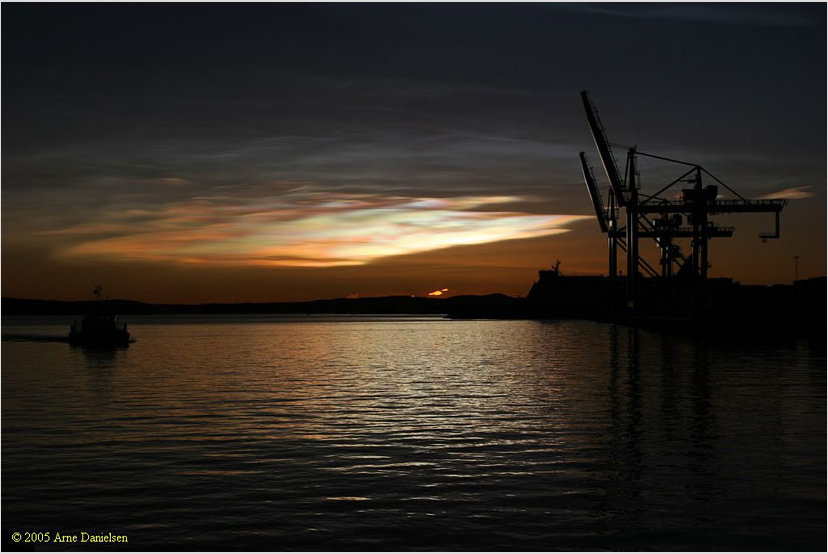Nacreous Clouds Norway 31st January 2005
Nacreous Clouds: A Mesmerizing Display Over Norway on January 31st, 2005
On the morning of January 31st, 2005, an awe-inspiring display of nacreous clouds graced the skies over Scandinavia, captivating the residents of Oslo and surrounding areas. These ethereal formations, also known as polar stratospheric clouds, were not only visible before dawn but persisted throughout the day, enchanting observers with their vibrant colors and intricate patterns. One particular evening appearance of these clouds was expertly captured by Arne Danielsen, an astrophotography and atmospheric phenomena enthusiast. The image he captured offers a glimpse into the mesmerizing beauty of these natural wonders.
Nacreous clouds are a rare atmospheric phenomenon that occurs in the winter months at high latitudes, typically between 65° and 75° north or south. They form in the lower stratosphere, at altitudes of around 15 to 25 kilometers (9 to 16 miles) above the Earth's surface. These clouds are composed of tiny ice crystals, which refract sunlight and create stunning displays of vibrant colors. The unique conditions required for their formation make nacreous clouds a relatively infrequent occurrence.
The distinctive colors seen in nacreous clouds are a result of the scattering of sunlight by the ice crystals present within them. When sunlight passes through these tiny ice particles, it undergoes a process called diffraction, causing the different wavelengths of light to separate. This phenomenon is similar to the way a prism disperses light into its constituent colors. As a result, nacreous clouds often exhibit a range of hues, including vibrant pinks, purples, oranges, and blues. The interplay of these colors against the backdrop of the sky creates a truly mesmerizing spectacle.
The formation of nacreous clouds is closely linked to extremely cold temperatures in the stratosphere. These icy clouds typically occur during polar winters when temperatures plummet, reaching below -78°C (-108°F). These frigid conditions are necessary for the formation of ice crystals, which are responsible for the cloud's unique optical properties. As the polar vortex circulates in the stratosphere, it traps moisture and forms ice particles on which nacreous clouds can grow. The intricate patterns and structures observed within these clouds are a testament to the complex interplay between temperature, moisture, and atmospheric dynamics.
Nacreous clouds are not only a visual treat but also serve as an indicator of specific atmospheric conditions. The presence of these clouds can signal the presence of ozone depletion in the stratosphere. Certain chemical reactions involving chlorofluorocarbons (CFCs) can lead to the destruction of ozone molecules, resulting in a thinner ozone layer. This, in turn, allows more ultraviolet (UV) radiation from the Sun to reach the Earth's surface. Nacreous clouds are formed when this increased UV radiation reacts with chlorine compounds present in the polar stratosphere, further depleting the ozone layer.
While nacreous clouds are a sight to behold, they also have implications for our planet's climate. The presence of these clouds contributes to the complex balance of radiation in the atmosphere. The scattering of sunlight by ice crystals in nacreous clouds reflects a portion of incoming solar radiation back into space, reducing the amount of energy absorbed by the Earth's surface. Understanding the dynamics and properties of nacreous clouds can provide valuable insights into the intricate mechanisms that govern our climate system.
The captivating display of nacreous clouds over Norway on January 31st, 2005, serves as a reminder of the beauty and complexity of our planet's atmosphere. These rare formations, with their vibrant colors and intricate patterns, offer a glimpse into the delicate interplay between temperature, moisture, and atmospheric dynamics. As we continue to study and appreciate the wonders of atmospheric optics, events like the one witnessed in Norway on that fateful day provide us with a renewed sense of wonder and appreciation for the natural world around us.

The great 31st January 2005 display over Scandinavia as seen from Oslo. The clouds were visible before dawn and throughout the day. Here is their evening appearance imaged by Arne Danielsen (astrophotography and atmospheric phenomena) -- Video of dawn clouds here. Image ©2005 Arne Danielsen, shown with permission.
Note: this article has been automatically converted from the old site and may not appear as intended. You can find the original article here.
Reference Atmospheric Optics
If you use any of the definitions, information, or data presented on Atmospheric Optics, please copy the link or reference below to properly credit us as the reference source. Thank you!
-
<a href="https://atoptics.co.uk/blog/nacreous-clouds-norway-31st-january-2005/">Nacreous Clouds Norway 31st January 2005</a>
-
"Nacreous Clouds Norway 31st January 2005". Atmospheric Optics. Accessed on November 26, 2024. https://atoptics.co.uk/blog/nacreous-clouds-norway-31st-january-2005/.
-
"Nacreous Clouds Norway 31st January 2005". Atmospheric Optics, https://atoptics.co.uk/blog/nacreous-clouds-norway-31st-january-2005/. Accessed 26 November, 2024
-
Nacreous Clouds Norway 31st January 2005. Atmospheric Optics. Retrieved from https://atoptics.co.uk/blog/nacreous-clouds-norway-31st-january-2005/.